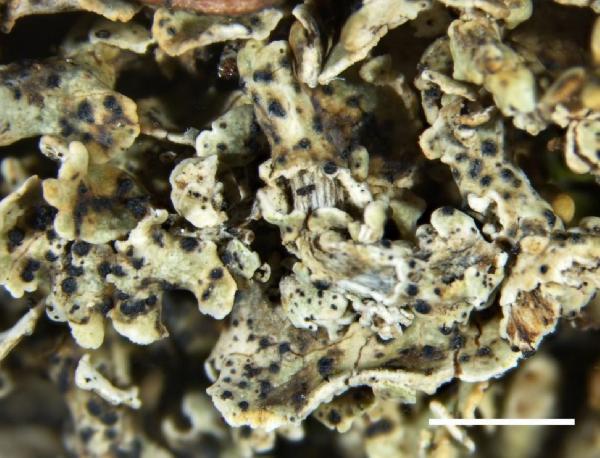Protothelenella santessonii H. Mayrhofer
Herzogia, 7, 3-4: 332, 1987.
Synonyms:
Distribution:
Description: Thallus inapparent, not lichenized, the hyphae developing inside the thalli of Cladonia-species, which are bleached and finally killed. Perithecia black, 0.1-0.2 mm across, ovoid to subpyriform, scattered, semi-immersed in the host thallus, without incolucrellum. Exciple dark brown and thick in upper part, paler and thinner at base; hamathecium of thread-like, richly branched and anastomosing pseudoparaphyses; hymenial gel hemiamyloid. Asci 8-spored, cylindrical, thick-walled, with two functional wall layers, the outer one I+ dull reddish, K/I+ blue, the apex with an I+ blue, more or less layered apical apparatus. Ascospores submuriform, with 3-5 tranverse septa and a single longitudinal septum that sometimes does not extend to the apices, hyaline, ellipsoid, 18-24 x 10-12 µm. Photobiont absent. Spot tests: all negative (eventual positive reactions are due to the host thallus). Chemistry: not known, but probably without lichen substances.Note: an apparently rare, but widespread lichenicolous fungus delevoping on the squamules and podetia of Cladonia-species, strongly damaging the host. It seems to have a Holarctic distribution, and is also known from the Alps (Austria). To be looked for in Italy.
Growth form: Lichenicolous fungus
Substrata: soil, terricolous mosses, and plant debris
Reproductive strategy: mainly sexual
paras Cladonia-species

Predictive model
Growth form: Lichenicolous fungus
Substrata: soil, terricolous mosses, and plant debris
Reproductive strategy: mainly sexual
paras Cladonia-species

Predictive model


